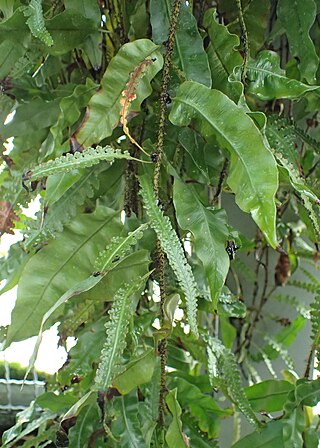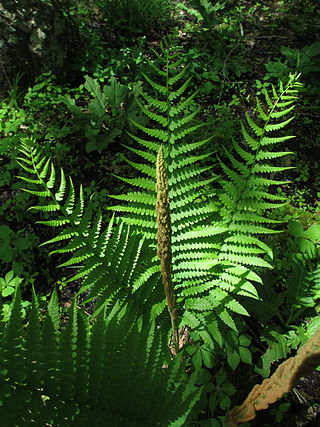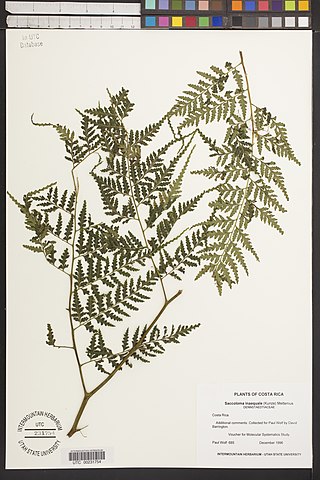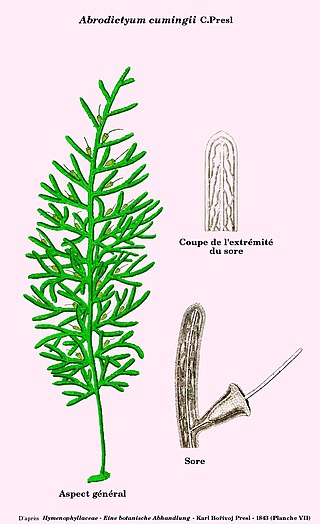
Osmundaceae is a family of ferns containing four to six extant genera and 18–25 known species. It is the only living family of the order Osmundales in the class Polypodiopsida (ferns) or in some classifications the only order in the class Osmundopsida. This is an ancient and fairly isolated group that is often known as the "flowering ferns" because of the striking aspect of the ripe sporangia in Claytosmunda, Osmunda, Osmundastrum, and Plensium. In these genera the sporangia are borne naked on non-laminar pinnules, while Todea and Leptopteris bear sporangia naked on laminar pinnules. Ferns in this family are larger than most other ferns.

Osmunda is a genus of primarily temperate-zone ferns of family Osmundaceae. Five to ten species have been listed for this genus.

The order Cyatheales, which includes most tree ferns, is a taxonomic order of the fern class, Polypodiopsida. No clear morphological features characterize all of the Cyatheales, but DNA sequence data indicate the order is monophyletic. Some species in the Cyatheales have tree-like growth forms from a vertical rhizome, others have shorter or horizontal expanding rhizomes.

Oleandra is a genus of ferns. In the Pteridophyte Phylogeny Group classification of 2016, it is the only genus in the family Oleandraceae, which is placed in suborder Polypodiineae, order Polypodiales. Alternatively, the family may be placed in a very broadly defined family Polypodiaceae sensu lato as the subfamily Oleandroideae.

Claytosmunda is a genus of fern. It has only one extant species, Claytosmunda claytoniana, the interrupted fern, native to Eastern Asia, Eastern United States, and Eastern Canada.

Osmundastrum is genus of leptosporangiate ferns in the family Osmundaceae with one living species, Osmundastrum cinnamomeum, the cinnamon fern. It is native to the Americas and eastern Asia, growing in swamps, bogs and moist woodlands.

Saccoloma is a fern genus in family Saccolomataceae. It is the only genus in the family in the Pteridophyte Phylogeny Group classification of 2016, but further investigation is needed. It is pantropical and its species are found in wet, shaded forest areas. Saccoloma species are characterized by an omega-shaped (Ω) vascular bundle in the cross-sections of their petioles. The common name soralpouch fern is used for Saccoloma.

Didymochlaena is a genus of fern with only one species, Didymochlaena truncatula, also known under the synonym Didymochlaena sinuosa. In the Pteridophyte Phylogeny Group classification of 2016, it is the only genus in the family Didymochlaenaceae. Alternatively, the family may be placed in a very broadly defined family Polypodiaceae sensu lato as the subfamily Didymochlaenoideae. It is commonly grown as a house plant, and is sometimes known as the mahogany maidenhair.

The Leptopteris is a small genus of ferns native to the New Guinea, Australia, New Zealand, and the Pacific Islands. They are similar to ferns in the related genus Todea, and were originally included in that genus. However, the very thin fronds of Leptopteris differ from the thick leathery fronds of Todea, and the genera are considered distinct. A probable extinct species, Leptopteris estipularis is known from the Early Cretaceous of India.
Plenasium angustifolium is a fern in the family Osmundaceae. The genus Plenasium is recognized in the Pteridophyte Phylogeny Group classification of 2016 (PPG I); however, some sources place all Plenasium species in a more broadly defined Osmunda, treating this species as Osmunda angustifolia. It is native to eastern Thailand, Laos and southern China, and has been introduced into India and Sri Lanka.

Plenasium banksiifolium is a fern in the family Osmundaceae. The genus Plenasium is recognized in the Pteridophyte Phylogeny Group classification of 2016 (PPG I); however, some sources place all Plenasium species in a more broadly defined Osmunda, treating this species as Osmunda banksiifolia. It is native along the Pacific coast of Asia, being found in the Kamchatka Peninsula, the Ryukyu Islands, Japan, southeast China, Taiwan, the Philippines, Borneo, Sulawesi and Java. P. banksiifolium, which can reach a height of 1.5 m, is the largest species in the genus and has ornamental value.
Plenasium javanicum is a fern in the family Osmundaceae. The genus Plenasium is recognized in the Pteridophyte Phylogeny Group classification of 2016 (PPG I); however, some sources place all Plenasium species in a more broadly defined Osmunda, treating this species as Osmunda javanica. It has a wide native distribution in south-eastern Asia, being found in the Eastern Himalaya, south-central and south east China, Indochina, the Philippines, Borneo, Sumatra, Sulawesi and Java.

Metaxya is a neotropical genus of ferns in the order Cyatheales. It is the only genus in the family Metaxyaceae in the Pteridophyte Phylogeny Group classification of 2016. Alternatively, the genus may be placed in the subfamily Metaxyoideae of a more broadly defined family Cyatheaceae, the family placement used in Plants of the World Online as of November 2019.

Pityrogramma, the silverback ferns, or goldback ferns, is a fern genus in the subfamily Pteridoideae of the family Pteridaceae.

Vandenboschia is a fern genus in the family Hymenophyllaceae. The genus is accepted in the Pteridophyte Phylogeny Group classification of 2016 but not by some other sources.

Abrodictyum is a fern genus in the family Hymenophyllaceae. The genus is accepted in the Pteridophyte Phylogeny Group classification of 2016 but not by some other sources, which sink it into a broadly defined Trichomanes.
Syngramma is a genus of ferns in the subfamily Pteridoideae of the family Pteridaceae. Species are native to south-east tropical Asia and the Pacific.
Tryonia is a genus of ferns in the subfamily Pteridoideae of the family Pteridaceae. Species are native to the east of Brazil and to Uruguay.
Polytaenium is a genus of ferns in the subfamily Vittarioideae of the family Pteridaceae. Species are native to Mexico and Southern America.

Osmundastrum pulchellum is an extinct species of Osmundastrum, leptosporangiate ferns in the family Osmundaceae from the lower Jurassic (Pliensbachian-Toarcian?) Djupadal Formation of Southern Sweden. It remained unstudied for 40 years. It is one of the most exceptional fossil ferns ever found, preserving intact calcified tissue with DNA and cells. Its exceptional preservation has allowed the study of the DNA relationships with extant Osmundaceae ferns, proving a 180-million-year genomic stasis. It has also preserved its biotic interactions and even ongoing mitosis.













